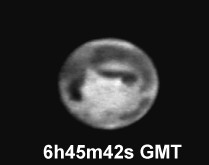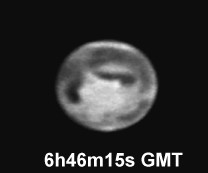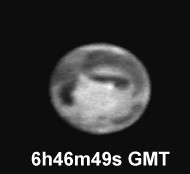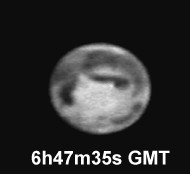



Dear Masatsugu:
Attached please find a sequence of four composite images (composed of 9 frames each) from 7 June, 2001 depicting the flares at Edom Promintorium. The file names correspond to times, i.e. 064542UTmaxREV.tif was taken at 06 hours 45 minutes 42 seconds UT; the suffix "max" denotes a brightness maximum, while "min" denotes a brightness minimum. All images were processed identically.
We are all indebted to astrovideographer David Moore of Phoenix, Arizona, who invested many hours examining the videotapes, tediously registering and stacking individual frames, and skillfully processing the resulting composite images. He was an invaluable member of the Florida Keys Mars expedition.




Accompanying verbal descriptions:
06h:45m:42s Intensely bright, almost stellar flare.
06h:46m:15s Brightness waning.
06h:46m:49s Brightness increasing again.
06h:47m:35s Abrupt decrease in brightness, but still brighter than polar hood and morning limb arc.
By the way, I believe that the discrepancies between the 1954 Japanese ephemeris values for De and Ds and those produced by Jeff Beish's WIMP program can be attributed to the refinement of Martian cartographic coordinates circa 1973 that resulted from Mariner 9 data.
Warmest regards,
Tom
Dear Masatsugu
When compositing 9 consecutive frames for each of the first three images, the flares appeared to fluctuate in brightness on a very short time scale, but they do appear virtually stellar in each of the individual frames. The effect of compositing is that you obtain only an average position for the flare (due to ever-present atmospheric turbulence, even in the Florida Keys) and the flare is made to appear larger and more diffuse than it really is. The fourth frame (at a deep minimum) did occur in momentarily better seeing, but despite appearances to the contrary, the dimming flare was no more pointlike than in the previous frames. In fact, it was all but absent in many of the 9 frames. A similar case of distended=bright stellar images can be seen on Dennis DiCicco and Leif Robinson's video images of the occultation of 28 Sagitarii by the rings of Saturn in 1989
The best animation would be assembled from a vast number of individual (not composited) frames (say every 10th frame), each one subjected to the same processing algorithm sequence (gamma adjust, unsharp masking, etc...). This is by no means an impossible feat, but it will take a bit of time, to be sure!
I am inclined to agree with you that the condition De=Ds may be quite special, and that these "flare" events are not as common as Professor Gaskell imagines. Walter Haas has written that he believes that they are very rare or that he would have seen them, given the untold hundreds of hours he has spent scrutinizing Mars since the 1930s.
Your explanation of a reflector lying at the bottom of a narrow depression is an insightful and plausible explanation.
Tom